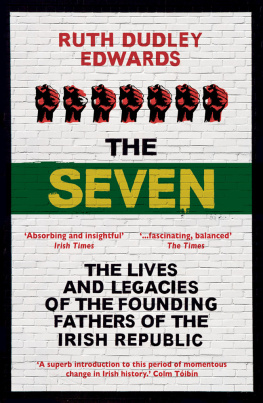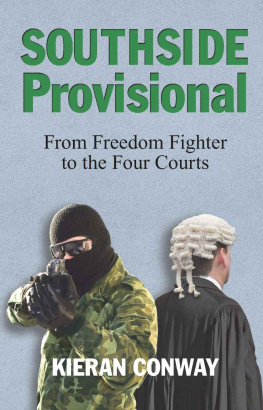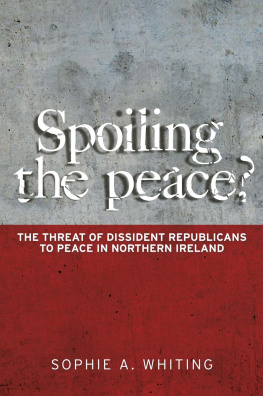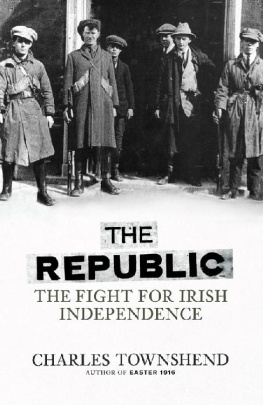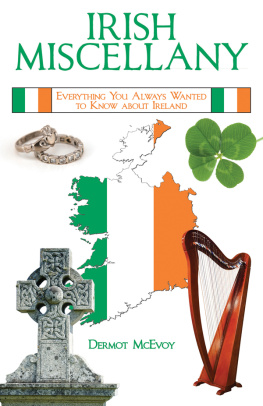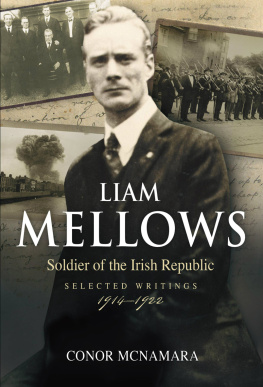A BROAD CHURCH
This book is dedicated to my late grandfather, Michael, for his never-ending support, encouragement and generosity.
Gearid Faolen was awarded a PhD in Modern Irish History from the University of Limerick in 2014 and currently works in scholarly publishing in London. He is a member of the Oral History Network of Ireland and The Irish Association of Professional Historians.
A BROAD CHURCH
THE PROVISIONAL IRA IN
THE REPUBLIC OF IRELAND,
19691980
Gearid Faolen

First published in 2019 by
Merrion Press
An imprint of Irish Academic Press
10 Georges Street
Newbridge
Co. Kildare
Ireland
www.merrionpress.ie
Gearid Faolen, 2019
9781785372452 (Paper)
9781785372469 (Kindle)
9781785372476 (Epub)
9781785372483 (PDF)
British Library Cataloguing in Publication Data
An entry can be found on request
Library of Congress Cataloging in Publication Data
An entry can be found on request
All rights reserved. Without limiting the rights under copyright reserved alone, no part of this publication may be reproduced, stored in or introduced into a retrieval system, or transmitted, in any form or by any means (electronic, mechanical, photocopying, recording or otherwise) without the prior written permission of both the copyright owner and the above publisher of this book.
Typeset in Minion Pro 11/15 pt
Cover front: Photo by PL Gould/Images/Getty Images.
Cover back: Benbulbin, Co. Sligo, 1977
(photo courtesy of An Phoblacht ).
CONTENTS
INTRODUCTION
The Troubles arose primarily out of the Northern Irish states hostile reaction to the civil rights campaign. Secondary to this was the Irish republican perspective of unfinished business with regard to the partition of the island. Accepting 1998 as the principal cessation of this period of violence, the number of deaths during the preceding thirty years stands at over 3,500. While the conflict proper may have receded, the psychological and emotional damage engendered by it did not simply disappear on 10 April 1998.
Most actions during the thirty-odd years of the Troubles occurred within the Northern state. However, international actors played a crucial role which all protagonists were party to. Republican, and to a lesser extent, pro-British paramilitaries sourced armaments from abroad. British Army and IRA operations were conducted across mainland Europe. Groups and individuals in North America played a crucial role in supplying Irish republicans with money and weapons. Many of these people later helped to further the cause of peace. A great number of the ancillary events of the conflict occurred in Britain. Beginning in late 1971, England was the target of an increasing number of IRA bombings, robberies, armed robberies and gun attacks. Neither Scotland nor Wales were considered legitimate targets by the Provisional or indeed the Official republican movement.
The Provisional IRA was a principal party to the conflict. Their origins lie primarily in the aftermath of sectarian pogroms in Northern Ireland during 1969, attacks which were themselves a response to the campaign of the Northern Ireland Civil Rights Association. As the largest and most active militant republican organisation, the Provisional IRA maintained a campaign against the British state for three decades. As a result of that campaign, they were responsible for over 1,500 deaths; many hundreds of these were the deaths of civilians. Their political wing, Sinn Fin, was party to the eventual peace talks in the 1990s and is now the largest nationalist party in Northern Ireland. The Provisionals drew considerable support from areas such as west Belfast, south Armagh, east Tyrone and the Catholic areas of Derry city. Their support base also stretched across the entirety of the Republic of Ireland. Irredentist sentiment in that state persevered from the time of partition. For most of its citizens, reunification remained a considered aspiration. It was embodied in the states constitution. For republicans, militant and constitutional alike, the North represented unfinished business. The escalation of events from 1968 allowed for the galvanising of public opinion in that respect. Indeed, many of the founders of the Provisional IRA were from the South. For them and others, there was undisputed continuity to the Provisionals with respect to the separatist republican tradition in Ireland.
The Republic of Ireland is perhaps the most overlooked of all the theatres of the conflict during the Troubles. The largest single loss of life in one day during the conflict occurred there in May 1974, when pro-British paramilitaries exploded no-warning bombs in Dublin city and Monaghan town. Thirty-three people were killed and scores more injured. By the end of the 1970s, the Southern state had experienced bombings, kidnappings, shootings and assassinations, armed robberies, police brutality and state censorship. It was far from untouched by the Troubles. Active republicans and much of the broader population in the South contributed to the Provisional IRAs campaign. Safe houses, training camps, arms supply routes and bomb factories existed in the Republic. Hundreds if not thousands of young men and women from that state joined the IRA as volunteers during the 196998 period. The state responded in a variety of ways to this. At the beginning of the conflict, an attitude and practice of toleration even support permeated official Ireland, whether the press, judiciary, security forces or elected representatives of mainstream political parties. After 1972, the bloodiest year of the conflict, this increasingly gave way to censorship, harsh legal measures and repression. Police brutality and forced confessions presented to juryless courts became part and parcel of the states campaign to defeat the IRA. These tactics developed against a backdrop of increasing lawlessness in the Republic engendered by the Provisional IRAs actions. This included the killing of members of the states security forces on occasion. As the 1970s progressed, militant republican support went underground. Nevertheless, emotive events such as the deaths of IRA hunger-strikers demonstrated that sympathy or support could be reactivated.
Numerous books have been published on various facets of the Troubles and its organisations, though far more works exist on republican than pro-British paramilitaries. In terms of fiction, Patrick Magee identified some 480 novels directly dealing with the conflict, with over 200 more works of prose.
This observation applies to many themes regarding militant republicanism. As noted, there are many works that focus on specific subjects. However, the history of the IRA particularly in the Republic of Ireland is far from definitively documented. No published study specifically details the role of the IRA in the South during the conflict. This is a major omission. One reason for this is the general lack of recognition about how integral the Southern state was to the longevity of the Provisional IRAs campaign. The island-wide organisation of the IRA ensured that the South would be exploited to the full to help prosecute the campaign in the North. Many IRA volunteers from the Republic served prison sentences in Northern Irish prisons during the conflict and vice versa. To understand just how organised the Provisionals were as a cross-border organisation, the hunger-strikes in Portlaoise prison during the 1970s give some indication. Of the dozens of participants who took part in those hunger-strikes, there were men from every province. Most of the counties on the island were represented.
In her peoples history of the English Civil War, Diane Purkiss noted one historians reference to that conflict as the war of the five peoples: English, Scots, Irish, Welsh and Cornish. The assertion was that each saw the war differently. Purkiss went further, arguing that one could as easily refer to it as a war of two million people, each with his or her own perspective shaped by national or regional identity or religious conviction or social and familial tradition or, simply, personality, luck and experience.
Next page


